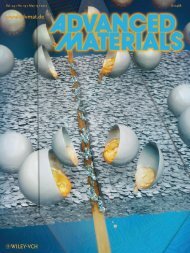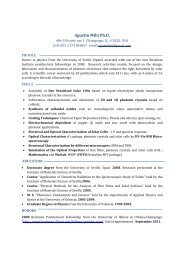Polymer Brushes for Molecular Transport - Paul Braun Research ...
Polymer Brushes for Molecular Transport - Paul Braun Research ...
Polymer Brushes for Molecular Transport - Paul Braun Research ...
Create successful ePaper yourself
Turn your PDF publications into a flip-book with our unique Google optimized e-Paper software.
Almost all available polymerization techniques have been applied to graft polymers from<br />
substrates. These includes, living ring opening polymerization, living anionic polymerization,<br />
living cationic polymerization, ring opening methathesis polymerization (ROMP), nitroxide-<br />
mediated polymerization, atom transfer radical polymerization (ATRP), reversible addition-<br />
fragmentation chain transfer (RAFT) polymerization.[3, 16, 19]<br />
We are particularly interested in surface-initiated ATRP due to the excellent features of<br />
ATRP:[20, 21] First, the polymerization can be carried out in mild conditions such as at room<br />
temperature and in aqueous solutions; second, a broad range of vinyl monomers can be<br />
polymerized through ATRP, including styrenes, acrylates and methacrylates, acrylonitriles,<br />
acrylamides and methacrylamides, acrylic acids and methacrylic acids; third, the polymerization<br />
is a controlled/“ living” radical chain reaction, and thus the polymer film thickness is easily<br />
controllable by adjusting the polymerization time or changing the monomer concentrations.<br />
1.2.3 Grafting via surface-attached monomers<br />
In this approach, polymerizations are carried out at the presence of substrates onto which<br />
functionalized monomers have been attached. The surface-attached monomers are incorporated<br />
into growing polymer chains in the same way as the monomers in solution (the monomers in<br />
solution are usually different from the surface-attached ones).[16] At the initial stage of<br />
polymerization, the polymerization rate <strong>for</strong> both the surface-attached monomers and the “free”<br />
monomers in solution should be identical; at the later stage, the surface is crowded with<br />
permanently attached oligomers or polymers, and the concentration of “free” monomer becomes<br />
very small. The surface polymerization could occur through two routes: (1) a macroradical<br />
attacks the free radicals on the surface (“grafting to”), or (2) the “free” monomers attach to the<br />
free radicals (“grafting from”). It has been shown that the “grafting to” step is the attaching<br />
8




